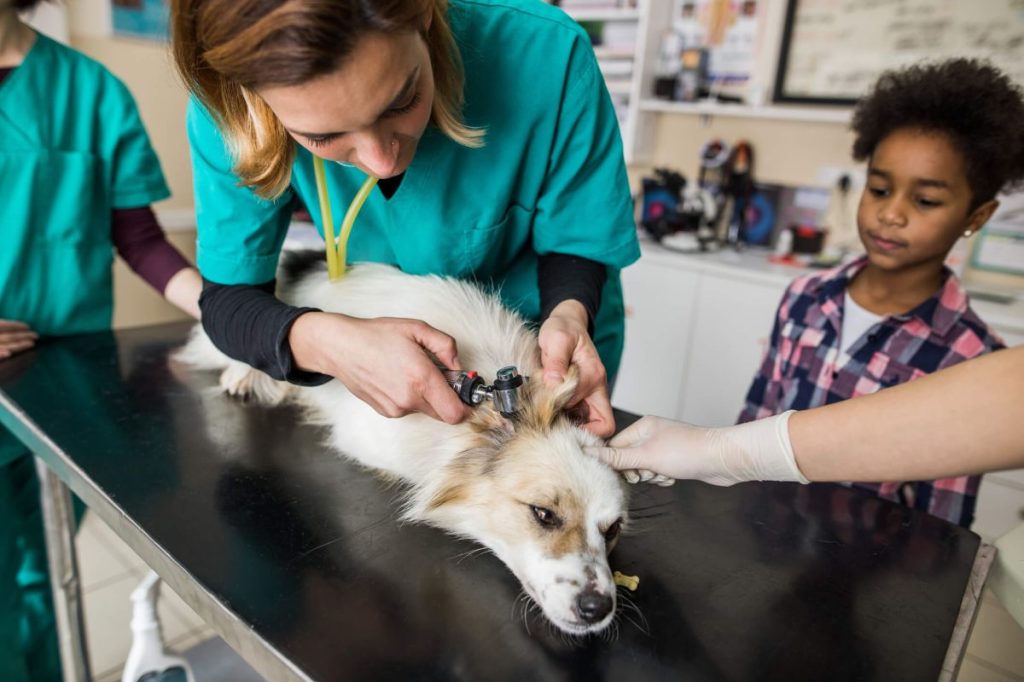Cephalexin is a broad-spectrum antibiotic commonly prescribed for dogs to treat a variety of bacterial infections. As a first-generation cephalosporin, it is particularly effective against gram-positive and some gram-negative bacteria. This makes it a versatile option for managing conditions such as skin infections, urinary tract infections, bone infections, and respiratory tract infections. Cephalexin for dogs — sometimes spelled “cefalexin” — is available under several brand names, including Keflex, Rilexine, Sporidex, Biocef, and Keftab.
Here’s what you should know about the drug’s uses, dosage, and side effects for dogs.
Uses of cephalexin for dogs

Cephalexin works by interfering with the synthesis of the bacterial cell wall. Specifically, it binds to penicillin-binding proteins within the bacterial cell membrane, thereby inhibiting the final transpeptidation step — cross-linking — of peptidoglycan synthesis. This results in cell lysis and, ultimately, the death of the bacteria. Because it targets the cell wall, cephalexin is especially potent against actively growing bacteria.
Veterinarians may prescribe cephalexin for various conditions, including but not limited to:
- Skin infections: Cephalexin is highly effective against Staphylococcus pseudintermedius, a common causative agent of pyoderma in dogs. It is also used to treat abscesses and cellulitis.
- Respiratory infections: Conditions such as bronchitis and pneumonia in dogs can be managed with cephalexin, owing to its efficacy against respiratory pathogens.
- Urinary tract infections (UTIs): Cephalexin is typically prescribed for UTIs in dogs, as it can eliminate bacteria in the urinary tract, reducing symptoms like frequent urination, blood in the urine, and discomfort.
- Bone infections: Osteomyelitis — an infection of the bone — can be treated with cephalexin due to its ability to penetrate bone tissue.
- Ear infections: Otitis externa and other ear infections caused by bacteria may also be treated with this antibiotic.
Dosage of cephalexin for dogs

The following is a guideline for the typical use of the drug in dogs and must not replace your vet’s advice for your individual pet.
The dosage of cephalexin for dogs can vary based on the type and severity of the infection, as well as the animal’s weight and overall health. Treatment with cephalexin usually spans from seven to 28 days, depending on the infection being treated. As such, it is essential to follow your veterinarian’s prescription accurately to ensure effective treatment and reduce the risk of antibiotic resistance.
Cephalexin can be administered orally in the form of capsules, tablets, or a liquid suspension. The liquid form is often preferred for dogs who have difficulty swallowing pills. You can give the medication to your pup with or without food, although administering it with food can help reduce gastrointestinal side effects.
If you miss giving your dog a dose of cephalexin, administer the missed dose as soon as you remember. However, if it’s almost time for the next scheduled dose, skip the missed dose and continue with the regular dosing schedule. Do not double up on doses to make up for the missed one, as this could increase the risk of side effects. To help prevent missed doses in the future, consider setting a reminder or using a medication tracker. If you have any concerns or if your dog misses multiple doses, consult your vet for further advice. They may adjust the treatment plan or provide additional guidance to ensure your dog’s infection is properly managed.
Side effects of cephalexin for dogs

While cephalexin is generally safe, it can cause side effects in some dogs. These may include:
- Nausea
- Vomiting
- Diarrhea
- Loss of appetite
- Drooling
- Lethargy
- Restlessness
- Increased thirst
Although rare, some dogs may develop an allergic reaction. This could manifest as itching, rash, difficulty breathing, or swelling of the face, lips, or tongue. If you suspect an allergic reaction, take your dog to the vet immediately.
Cephalexin should be avoided in dogs with a known allergy to cephalosporins or penicillins. Moreover, the safety of this medication in pregnant or lactating dogs has not been well established, so it should only be administered when absolutely necessary and under strict veterinary guidance. Additionally, cephalexin is contraindicated in dogs with pre-existing kidney or liver conditions, as these organs are integral in metabolizing and excreting the drug.
While cephalexin has no known drug interactions in dogs, it could potentially increase the effects of blood thinners and diuretics. As a precaution, inform your veterinarian about any other medications or supplements your dog is taking before starting treatment.
Make sure to store cephalexin tablets and capsules at room temperature — typically between 68°F to 77°F — away from moisture and light. If the medication is in liquid form, it may require refrigeration. However, always follow the specific storage instructions provided by the veterinarian or as indicated on the prescription label. Remember to keep the medication out of reach of children and pets to prevent accidental ingestion. Symptoms of overdose may include vomiting, diarrhea, lethargy, and, in severe cases, seizures. In the event of an overdose, contact your vet or the Pet Poison Helpline at (855) 764-7661 for urgent advice.




